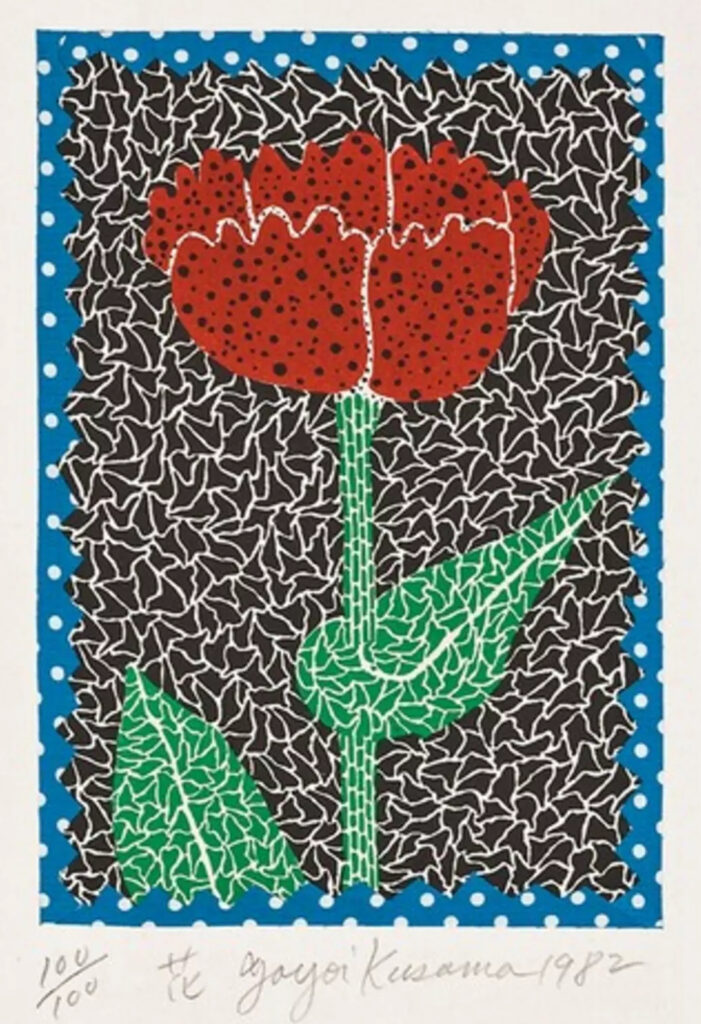
Yayoi Kusama, one of the most influential contemporary artists of the 20th and 21st centuries, is celebrated for her unique visual language that blends vibrant patterns, surrealist motifs, and psychological themes. Her piece “Flower” (1982) stands out as a significant example of her exploration into themes of nature, repetition, and the psyche. Created during a period when Kusama was returning to her roots in organic forms and reflecting on the delicate balance between beauty and chaos, “Flower” exemplifies the artist’s ability to transform a simple natural motif into a captivating, almost hypnotic experience.
Historical and Artistic Context
Kusama’s artistic journey is deeply rooted in her personal struggles with mental health and her search for identity. Her work in the 1980s, including “Flower” emerged from a period of relative stability after her voluntary return to Japan in the late 1970s. Having gained international recognition for her avant-garde installations and performances in the 1960s, Kusama’s move to Japan marked a shift in her work’s tone. She began to revisit traditional Japanese aesthetics and techniques while maintaining her signature approach of repetitive patterns and vibrant colors. “Flower” reflects this shift, where Kusama embraces simplicity, focusing on singular floral forms that appear otherworldly in their intricate details and intensity of color.
Analysis of Flower (1982)
“Flower” is characterized by its vivid use of color, meticulous detailing, and repetitive patterns that draw the viewer into a contemplative state. The painting depicts a single flower that fills the canvas, its petals rendered in layers of contrasting hues that range from deep reds and purples to bright yellows and greens. The bold palette evokes both the beauty and intensity of nature, while the repetitive patterns within the petals suggest movement and growth, as if the flower is pulsing with life.
The central motif of the flower can be interpreted as a symbol of femininity, renewal, and resilience. Kusama’s choice to isolate the flower against a stark background highlights its importance, inviting viewers to engage with its form and meaning. The repetitive dots and lines within the petals are a hallmark of Kusama’s style, representing both an obsessive attention to detail and a sense of infinite expansion. This duality—between the finite form of the flower and the infinite repetition of patterns—creates a visual tension that is central to the impact of the piece.
Psychological and Philosophical Themes
Kusama’s art has long been linked to her experiences with hallucinations and obsessive-compulsive disorder, and “Flower” is no exception. The repetitive patterns within the flower’s petals can be seen as a manifestation of Kusama’s own psychological condition, where repetitive thoughts and images dominate her mental landscape. Yet, rather than being overwhelmed by these patterns, Kusama harnesses them to create a sense of order and harmony. The flower’s intricate patterns are not chaotic but rather follow a deliberate structure, suggesting that Kusama is using her art as a way to impose control over the uncontrollable aspects of her mind.
Philosophically, “Flower” engages with themes of life and death, growth and decay. The bright, almost electric colors of the flower suggest vitality, while the meticulous patterns and lines within its form imply a sense of impermanence and fragility. This tension between life and death is a recurring theme in Kusama’s work, reflecting her fascination with the cycle of existence and her desire to capture both its beauty and its transience.
Artistic Techniques and Influences
In “Flower” Kusama employs a range of techniques to create a dynamic visual experience. The use of contrasting colors and intricate detailing within the petals creates a sense of depth and movement, making the flower appear to vibrate against the canvas. Kusama’s brushwork is both precise and fluid, reflecting her control over the medium while also allowing for moments of spontaneity. The patterns within the petals are meticulously rendered, yet there is a sense of organic growth, as if the patterns are evolving on their own.
Kusama’s work in the 1980s was influenced by both traditional Japanese art and Western avant-garde movements. The use of repetitive patterns and vibrant colors in *Flower* can be linked to the traditional Japanese aesthetic principle of *wabi-sabi*, which celebrates imperfection and impermanence. At the same time, her exploration of obsessive repetition and the manipulation of space connects her work to Western surrealism and minimalism.
Significance and Legacy
“Flower” holds a special place within Kusama’s oeuvre, representing a period of introspection and renewal in her career. The painting is a testament to Kusama’s ability to find beauty in the ordinary and to elevate a simple motif into a profound visual and psychological experience. The singular focus on a flower, rendered in such detail and with such intensity, reflects Kusama’s commitment to exploring the depths of her own mind and her desire to share that exploration with the world.
The legacy of “Flower” and other works from this period can be seen in Kusama’s continued influence on contemporary art. Her use of repetitive patterns, vibrant colors, and psychological themes has inspired countless artists and continues to captivate audiences around the world. “Flower” serves as a reminder of the power of art to transform personal experience into universal meaning, and of Kusama’s unique ability to find harmony within chaos.
Yayoi Kusama’s “Flower” (1982) is a masterful exploration of the intersection between personal experience and universal symbolism. Through its vibrant colors, intricate patterns, and compelling narrative, the painting captures the essence of Kusama’s artistic philosophy—one that embraces both the beauty and complexity of the human experience. As with much of Kusama’s work, “Flower” invites viewers to look beyond the surface and to engage with the deeper psychological and philosophical themes that underpin her art. In doing so, it stands as a testament to Kusama’s enduring legacy as one of the most innovative and influential artists of our time.
No comments yet.








